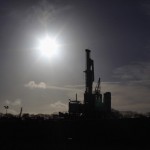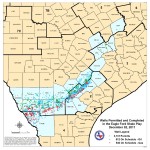Fracking’s Link to Smog Worries Some Texas Cities

Flaring gas at well site in DeWitt County
In South Texas, state environmental regulators are using helicopters equipped with infrared cameras to sweep across gas and oil well sites. They’re looking for toxic vapor leaks that otherwise would be invisible. The leaks are from open hatches or bad valves on tanks and pipes. But what the state is finding—and not finding—is part of the debate over whether fracking threatens to dirty the air in Texas towns where drilling is surging.
“We are being proactive in trying to look at and address these issues,” says David Brymer, director of air quality with the Texas Commission on Environmental Quality (TCEQ).
A TCEQ video shows fugitive emissions at a drilling site in the Eagle Ford Shale of South Texas.
Fracking and Smog
The fear is that the enormous increase in oil and gas well drilling, largely related to the technique called hydraulic fracturing or fracking, is releasing sizable amounts of gases. Among them, methane and volatile organic compounds (VOCs) like benzene. The federal government is convinced it’s a big deal.
“The oil and gas industry is a significant source of VOCs, which contribute to the formation of ground-level ozone (smog),” said the EPA in announcing new rules for drilling issued this April. The EPA said methane—what natural gas is made of—is a highly potent greenhouse gas. The agency blames oil and gas production and processing for “nearly 40% of all U.S. methane emissions.”
The EPA says of particular concern is “flowback,” one stage of drilling a well when a mix of natural gas and VOCs come to the surface “at high velocity and volume” for three to 10 days, according to the EPA.
San Antonio on Edge
It’s partly why San Antonio is worried. The city sits just north (and often downwind) of Karnes County, now the state’s number one producer of crude oil. It’s part of the Eagle Ford Shale, the underground rock formation that holds oil and gas that’s newly accessible using fracking. The area leads the state in new drilling permits and completed wells according to the Texas Railroad Commission, which regulates drilling.
“We’re at the early stages of growth of the Eagle Ford,” says Peter Bella, natural resources director for the Alamo Council of Governments.
“That’s why we want to try and understand it the best we can and get ahead of the curve and not be playing catch-up,” Bella told StateImpact.
Because it’s not just the air pollution from the wells. Bella says a more immediate concern is all the exhaust from the diesel engines in the thousands of trucks, generators and compressors used to service the well sites. That could push San Antonio over the edge.

Dave Fehilng/StateImpact
Tanker truck on ranch road near Cuero, Texas
“Right now, the San Antonio region is the largest city in the United States that is in full compliance with all air quality laws. I have to say in the same breath, we are right on the cusp of violating the ozone standard,” said Bella.
The industry has responded, partly through the Texas Railroad Commission. Commissioner David Porter is behind the Eagle Ford Task Force to work with drilling companies to target pollution sources, including an upshot in the number of flares used to burn off natural gas. Porter’s staff told StateImpact he was too busy for an interview.
North v. South…Texas
The oil and gas industry has run into far more opposition to its emissions in North Texas, home to the Barnett Shale. And to a lot more people. And pollution.
“It’s just adding to an existing problem,” said Lon Burnam, a Democratic state representative from Forth Worth who serves on the House Environmental Regulation Committee.
“Those of us in North Texas (have been) in non-attainment for so many years. We absolutely recognize the huge impact this is having, the negative impact on our air quality,” said Burnam.
“Chesapeake has put a gas well 537 feet from my back yard,” testified Rosemary Reed at a hearing held by the EPA last fall in Arlington. “And also flared that well,” Reed said of giant drilling company Chesapeake Energy.
Unlike in South Texas where much of the drilling is taking place in open ranges where the nearest home can be miles away, drilling in more densely-populated North Texas gets treated like a neighborhood nuisance, with city councils passing extensive ordinances requiring buffer zones between well sites and homes. Fort Worth mandates that drilling companies take steps to reduce air emissions.
‘Health Studies Haven’t Found Anything’
The drilling industry largely disputes any threat to health from the vapors the fracking unleashes. And so do Texas regulators. At least, for now.
“Lot of monitoring out there (in the Barnett Shale), lots of studies commissioned—done by us and other people—health studies, and they really haven’t found anything,” said the TCEQ’s Brymer.
Brymer said state investigators found that there’s nothing inherently wrong with the fracking process in terms of toxic emissions. Instead, he said most leaks were caused by workers not following procedures, for example, leaving a hatch door open on a tank.
“If it’s closed, it works the way it’s supposed to. If left open, you have increased emissions.”
Brymer also said that in the Eagle Ford Shale in South Texas, air monitors the TCEQ has in San Antonio are not showing any significant changes in ozone.
So no clear cut connection between all that drilling and the ozone levels?
“We haven’t seen anything yet,” said Brymer.




